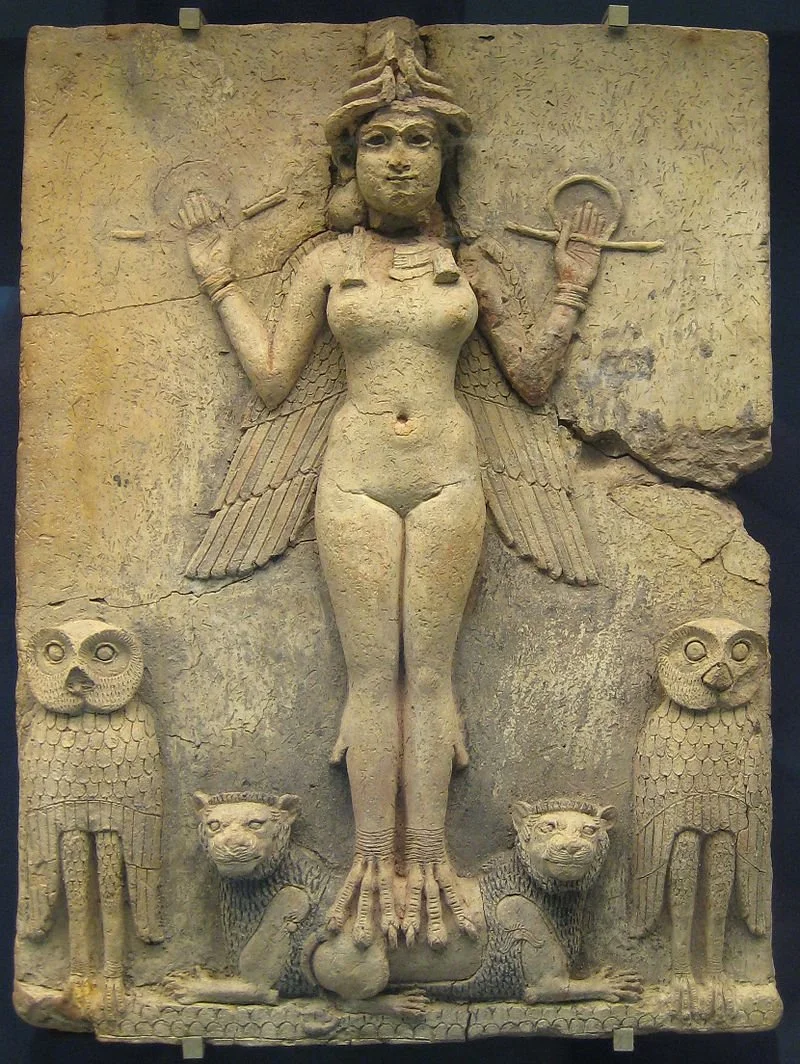Feminist Icon Or Evil Succubus?: Everything You Need To Know About Lilith
Maybe you know her from the Lilith Fair, founded by Sarah McLachlan in the late 1990s. Maybe you've seen her in popular culture, from the recent series The Chilling Adventures Of Sabrina to Marvel Comics in the ‘90s where she was the main villain of Ghost Rider, Morbius and the rest of the Midnight Sons.
Maybe you know her from Jewish mythology as Adam’s first wife. Or maybe you know her as the demon succubus with a fetish for infanticide. Whatever your preconceptions about the mother of djinn formerly known as Lilith, you’re probably right. The ancients called her the Mother of Night, the Sobber, the Female Dung Beetle, or my personal favorite—the Queen of Monday.
The archetype of Lilith, it turns out, contains multitudes.
Quick and dirty, what’s her deal?
According to Raphael Patai, anthropologist who specializes in long-standing Semitic tradition, “No she-demon has ever achieved as fantastical a career as Lilith, who started out from the lowliest of origins, was a failure as Adam’s intended wife, became the paramour of lascivious spirits, (and) rose to be the bride of Samael the Demon King” (qtd. in Legends of the Fire Spirits). In other words, Lilith has an extensive resume.
She’s probably best known for her place in the Abrahamic religions, particularly presented by medieval Kabbalistic Jewish legends. You know that unspecified amount of time between the creation of Adam and when Eve was created from his rib? According to the Kabbalists, that’s Lilith’s era.
Lilith was created out of the same clay used to create man, at the same time, with the intent of being Adam’s counterpart, but she was “unsuitable” as a wife.
In the Alphabet of Ben Sira, from the eighth to eleventh centuries (which is essentially an addendum to the Old Testament), Ben Sira explains Lilith’s origin to the King of the Babylonians, Nebuchadnezzar. In that story, Lilith refuses to have sex with Adam in the missionary position. She says, “I will not lie below,” utters the name of God (which is a great sign of power), took flight out of the Garden of Eden, and made her new home on the coast of the Red Sea.
The story goes on: in Ben Sira, Lilith mates with various demons she encounters, which creates succubus demons. Even then, the legend says Adam asked God to bring her back, so He dispatched three angels to pull up and convince her to come back to Eden. The angels threatened to kill one hundred of Lilith’s demon kids every day she spent away.
Lilith didn’t care.
Ben Sira states that she said, “I was created only to cause sickness to infants… if the infant is male, I have dominion over him for eight days after his birth, and if female, for twenty days.”
The antidote to that power, by the way, is invoking the names of the three angels dispatched to retrieve Lilith. Ben Sira included these names so that they could be transcribed on protective amulets, just in case (they are: Senoy, Sansenoy, and Semangelof, if you need them).
Oh. Is that all?
Hardly.
In Palestinian and Syrian legends, there’s a djinn identical to Lilith named Qarinah. She functions as a “spirit double,” which is a concept dating back to ancient Egyptian religion, and is generally understood to be an evil, non-God-fearing djinn.
Popular Arab tradition relates that the original Qarinah mated with Iblis (AKA Satan) to beget all the djinn—after she left Adam, that is. (FYI, these legends all seem to merge in the early centuries of Islam.) Because she was rejected by Adam, she hates humans.
Her favorite ways to torment humans are destroying children during pregnancy, infecting children with illness, and frightening new mothers into madness.According to the stories, she’s still salty about being dispossessed, and she hates that Adam cost her the role of “mother of humankind,” which was bestowed on his second wife, Eve.
She’s now known instead as “the mother of the djinn,” and she inspires fear instead of affection among the various peoples of the Middle East.
Her earliest mythology, though, before all of this I just said, appears in the third millennium BC, in the Sumerian King List, which recorded the empire’s kings and dynasties. Gilgamesh, the ancient hero himself, is listed as the paternal descendant of a Lillu-demon—Lillu was one of four demons belonging to a class of vampires and incubi/succubi who were originally wind and storm demons that came out of the desert to terrify people. (They were, essentially, djinn before they were called djinn.)
In the epic Gilgamesh, the titular hero even has an interaction with Lilith when he tried to rescue the huluppa tree for a goddess. She’s between him and the tree, and when she sees him coming, she smashes a house in panic, and then retreats into the desert, where she apparently still hangs out.
What does she look like?
The early, Sumerian-period Lilith was “believed to be beautiful” but sexually promiscuous and barren (again from Legends of the Fire Spirits)—which apparently, according to the syntax, are opposites?
And, when she chose a lover, she kept him captive without “truly satisfying him.”
By the second to fifth centuries AD, during the Talmudic period of Judaism, she appears as a fully developed she-demon, though, portrayed in a Babylonian terracotta relief standing on two lions, flanked by owls, wearing only a headdress with several sets of horns. #goals
By the 800s, by the time she developed all the major features of a baby killer, she was portrayed as a winged sphinx in Syria, and all you had to do to conjure her was say her name.
So… Lilith is, in fact evil?
It would seem so. All the ancients agreed on a general storyline that pits her against humankind at large. Or, at least, the ancient legends agreed that her kind of behavior couldn’t be allowed in polite society.
It seems like that narrative is more interested in utilizing that non-subservient behavior to articulate how women shouldn’t act, so that Lilith becomes more of a boogeyman for women who were thinking of independence… I mean, it’s the women whom Lilith is really out to destroy, right?
So, feminist icon or demon baby killer? You be the judge.
Wow.
Right? Ancient folklore is full of these fascinating and perhaps problematic beings, and I’d be remiss not to insist that if you’re interested in this myth, you should absolutely check out Robert Lebling’s book, Legends of the Fire Spirits, which is largely the source material for this article.
Come back in May for another helping of Friday Folklore from outside the western world!
Works Cited
Lebling, Robert. Legends of the Fire Spirits: Jinn and Genies from Arabia to Zanzibar. Counterpoint Press, 2010.
Patai, Raphael. The Hebrew Goddess. New York: Avon Books, 1978.





